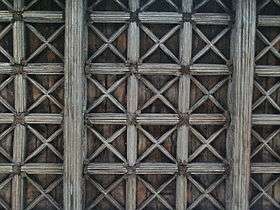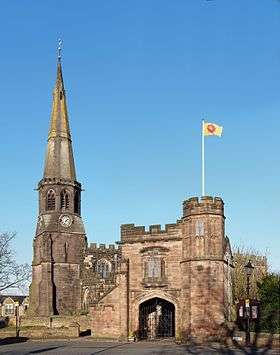Church of St Wilfrid, Standish
| Church of St Wilfrid, Standish | |
|---|---|
|
Church of St Wilfrid, Standish | |
 Church of St Wilfrid, Standish Location in Greater Manchester | |
| Coordinates: 53°35′14″N 2°39′41″W / 53.5872°N 2.6614°W | |
| OS grid reference | SD 563,103 |
| Location | Market Place, Standish, Wigan, Greater Manchester |
| Country | England |
| Denomination | Anglican |
| Website | St Wilfrid, Standish |
| Architecture | |
| Status | Parish church |
| Functional status | Active |
| Heritage designation | Grade I |
| Designated | 9 August 1966 |
| Architect(s) | L. Shipway (?) |
| Architectural type | Church |
| Style | Gothic and Renaissance |
| Administration | |
| Parish | Standish |
| Deanery | Chorley |
| Archdeaconry | Blackburn |
| Diocese | Blackburn |
| Province | York |
| Clergy | |
| Rector | Andrew Holliday |
| Curate(s) | Tim Brampton |
| Laity | |
| Reader(s) | Barbara Weston |
| Director of music | John Walton GRNCM FLCM FRCO |
| Organist(s) | Alan Banks LLCM |

The Church of St Wilfrid is in Market Place, Standish, Wigan, Greater Manchester, England. It is an active Anglican parish church in the Diocese of Blackburn. It is recorded in the National Heritage List for England as a designated Grade I listed building.[1] The authors of the Buildings of England series describe it as "one of the most interesting churches in Lancashire".[2]
History
The church is first mentioned in 1205 but the vast extent of the ancient parish with its eleven townships (Adlington, Anderton, Charnock Richard, Coppull, Duxbury, Heath Charnock, Langtree, Shevington, Standish, Welch Whittle and Worthington) points to a very early foundation. The church is believed to have been constructed between 1582 and 1584 and designed by L. Shipway. It is in a blended Gothic and Renaissance style.
During the 20th century the Lancaster architects Austin and Paley carried out work on the church. In 1913–14 they added vestries at the east end of the church,[3] and in 1926 they built a gatehouse at the entrance to the churchyard.[3] The gatehouse is listed separately from the church at Grade II.[4] The architects also supervised minor additions and repairs to the church in 1932 and 1939.[5]
Architecture
Exterior
The tower is 19th-century Gothic, of grey-black ashlar. The prominent spire has an octagonal bell-stage. The remainder of the church is of yellow-black gritstone. The nave and chancel are Elizabethan, from 1582–84. Of the nave, Simon Jenkins, in England's Thousand Best Churches, writes: "The nave arches seem undecided between Gothic and classical. They have tentative columns of a Tuscan order, while the arches above are Gothic, a most strange 'transitional' form."[6]
Interior
Jenkins describes the church as having "... the finest roof in Lancashire, worthy of Somerset's best. This is a Tudor work of panels and cross-braces covering nave, aisles and, most elaborate, the cancel. The vicar has studied the bosses and claims that no two are the same".[6] The pew ends in the Standish family chapel display the family crest of an owl with a rat.[6]
External features
The churchyard, which is divided into old and new sections, contains the war graves of four service personnel of World War I, and nine of World War II; most of the graves are in the new section.[7]
See also
| Wikimedia Commons has media related to Church of St Wilfrid, Standish. |
- Grade I listed churches in Greater Manchester
- List of churches in Greater Manchester
- List of ecclesiastical works by Austin and Paley (1895–1914)
- List of ecclesiastical works by Austin and Paley (1916–44)
References
Citations
- ↑ Historic England, "Church of St Wilfrid, Standish (1287160)", National Heritage List for England, retrieved 21 August 2012
- ↑ Pollard & Pevsner 2006, p. 590.
- 1 2 Brandwood et al. 2012, p. 249.
- ↑ Historic England, "Gatehouse to Church of St Wilfrid, Standish (1228470)", National Heritage List for England, retrieved 21 August 2012
- ↑ Brandwood et al. 2012, pp. 251, 253.
- 1 2 3 Jenkins 1999.
- ↑ STANDISH (ST. WILFRID) CHURCHYARD, Commonwealth War Graves Commission, retrieved 7 February 2013
Sources
- Brandwood, Geoff; Austin, Tim; Hughes, John; Price, James (2012), The Architecture of Sharpe, Paley and Austin, Swindon: English Heritage, ISBN 978-1-84802-049-8
- Jenkins, Simon (1999), England's Thousand Best Churches, London: Penguin Books, ISBN 978-0-14-103930-5
- Pollard, Richard; Pevsner, Nikolaus (2006), Lancashire: Liverpool and the South-West, The Buildings of England, New Haven and London: Yale University Press, ISBN 0-300-10910-5
